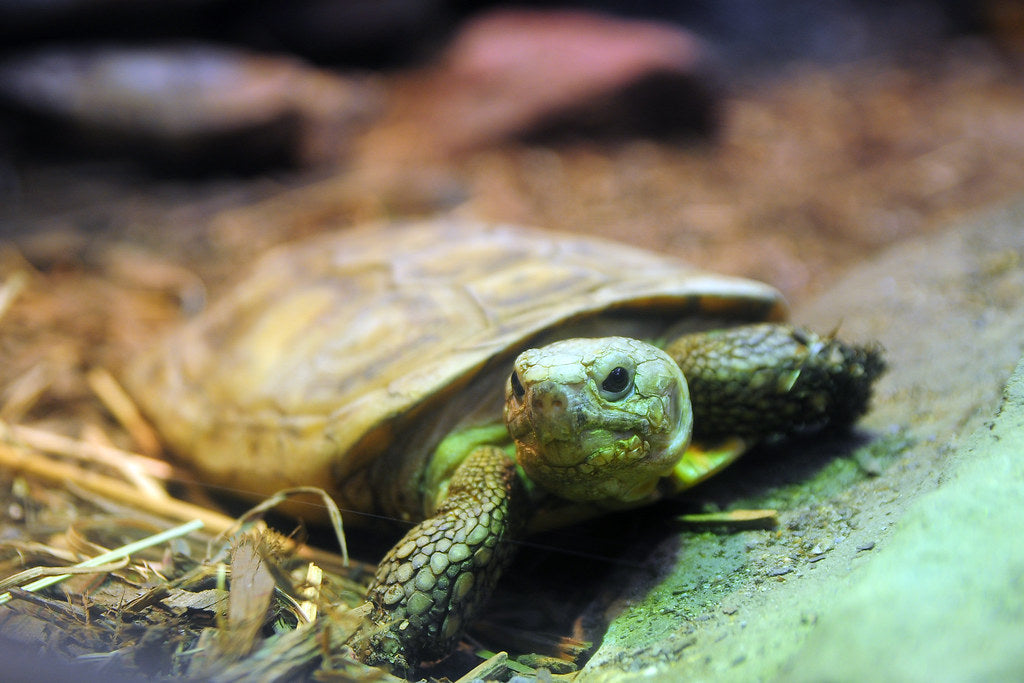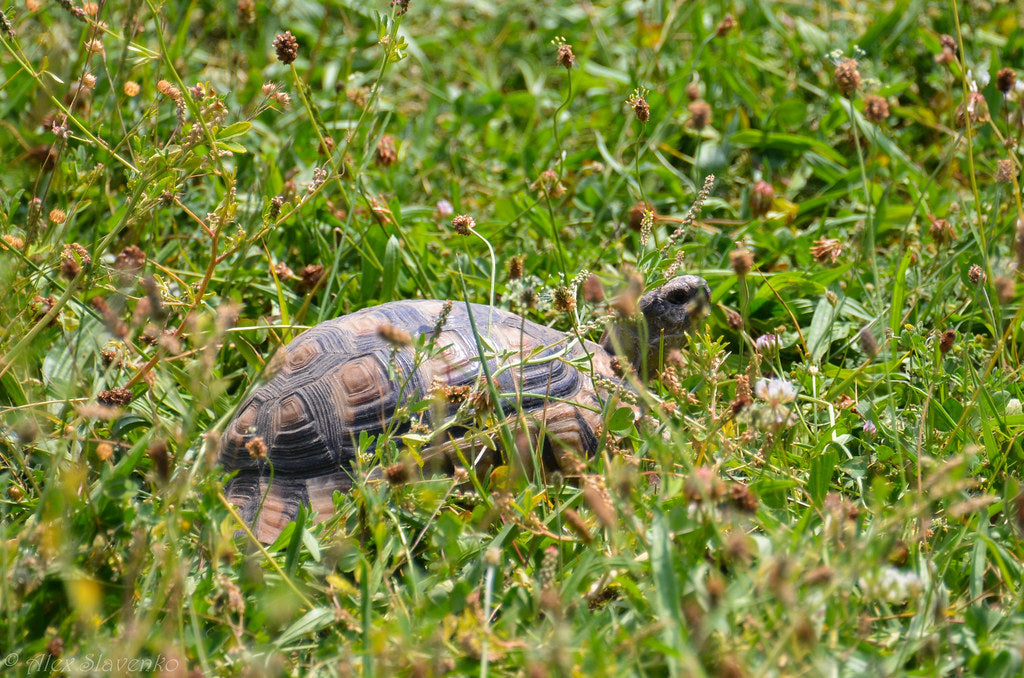Pancake tortoises (Malachochersus tornieri) are a small species of tortoise native to Tanzania and Kenya. They prefer arid savanna and scrub habitats with plenty of rock cover.
Pancake tortoises are typically 5-6” long, although they can be as large as 7”. Something that makes these tortoises incredibly unique is, as their name suggests, they have an incredibly flat body shape! Instead of having a big dome for a shell, pancake tortoise shells are thin and soft, which allows them to hide from predators by squeezing into the crevices between and under rocks. They also have unusually mobile limbs, which makes them skillful climbers.
This is an intermediate-level pet tortoise, as they are sensitive to low temperatures and high humidity, and their unique ability to climb makes them escape artists. With good care, a pancake tortoise can live at least 35 years.
How much space do pancake tortoises need?
A single pancake tortoise should be housed in an enclosure no smaller than 36”L x 24”W x 24”H, although larger is preferred. If you can provide larger, do it! Although pancake tortoises don’t need much in the way of humidity, tortoise tables are not a good idea for housing this species because of their ability to climb.
Once your tortoise is an adult, it’s optimal to keep them in an outdoor pen, if your local climate is suitable. Aside from providing free heat and UVB, outdoor pens make it easy to provide a much larger enclosure for your pet. The walls of this pen should be too smooth to climb and rise at least 24” above ground level, with a generous lip around the top of the walls to prevent determined tortoises from climbing out. Anti-predator measures should also be in place. Pancake tortoises must be brought indoors during the winter in most parts of the United States, and they do not hibernate.
Pancake tortoises are often found living communally, and do well in groups. An extra 2 sq. ft. of floor space (minimum) should be allowed for each additional tortoise. Do not house males and females together if you don’t plan to breed, and keeping multiple males together may lead to fighting.
Do pancake tortoises need UVB?
Yes. Aside from helping provide a day/night cycle and an infinite supply of vitamin D, UVB is also essential to your tortoise’s overall health. The best UVB bulbs for pancake tortoises are:
- Arcadia T5 HO 12%
- Zoo Med T5 HO Reptisun 10.0
The bulb should be roughly half the length of the enclosure and mounted in an Arcadia or Vivarium Electronics fixture, placed on the same side as the heat lamp. The UVB lamp should be 14-17” above the top of the tortoise’s shell for best results. If there is mesh between the lamp and the tortoise, then this distance should be reduced to 10-12”, as mesh partially blocks UVB wavelengths.
Because pancake tortoises are desert animals, they are likely to do best when their enclosure is brightly illuminated. Add a strong 6500K LED or T5 HO fluorescent grow light to energize your tortoise and better simulate daylight.
All lighting should be on for 12 hours/day.
What basking temperatures do pancake tortoises need?
Pancake tortoises should be kept with a substrate surface temperature of 108°F under the heat lamp, with a cool area on the other side of the enclosure between 70-75°F. Temperatures should never get lower than 68°F, even at night. Temperature should be measured with a temperature gun.
To create a basking area for your pancake tortoise, use a halogen flood heat lamp placed on one side of the enclosure, mounted at the same height as the UVB lamp to provide even heating. Do not use ceramic heat emitters (CHEs), heat mats, red bulbs, or blue bulbs, as these are not as effective.
If you are housing your pancake tortoise outdoors, make sure part of the pen is shaded. Provide a heated tortoise “house” kept dry and maintained at 68-70°F for them to use when the weather gets too cool.
What humidity levels do pancake tortoises need?
As an arid species, adult pancake tortoises can survive fairly low humidity levels. It’s best practice to provide access to areas of higher humidity to help them stay hydrated. One of the best ways to do this is by offering a tight-fitting humid hide for the tortoise to use as needed.
Juvenile and particularly hatchling pancake tortoises require higher humidity to facilitate proper shell growth and development. Shoot for 50-60% humidity during the day and around 80% at night. You can increase humidity by regularly misting the enclosure with a sprayer.
Humidity should be measured by a digital probe hygrometer with the probe in the middle of the terrarium.
What substrate is good for pancake tortoises?
It’s ideal to use a substrate that imitates what pancake tortoises naturally live on in the wild. In other words, you’ll need something that resembles sandy soil. If you are housing your tortoise outdoors, then unless you have moist clay soil, what you already have in your yard is likely fine. However, it’s best not to house pancake tortoises on grass lawn, as this is likely to make the humidity too high.
If you are housing your tortoise indoors, we recommend plain topsoil mixed 60/40 with play sand by volume. Substrates should be at least 3” deep and completely replaced every 6 months. Remove poop and urates daily, along with contaminated substrate.
What décor can you use in a pancake tortoise enclosure?
It’s terribly boring for a reptile to be stuck in an enclosure with nothing in it except substrate, a hide, and food/water bowls. It doesn’t matter how big the enclosure is if you don’t put things in it for your pet to use and interact with.
The most important décor to place in your pancake tortoise’s enclosure (aside from hiding places), is a well-secured, tall rock stack. This gives them the opportunity to climb as a natural behavior, strengthens their muscles, and also files down their nails!
Here are some décor ideas that are appropriate for pancake tortoises:
- additional hiding places/burrows
- logs
- live, edible plants
You can also shape the substrate into hills to provide an extra challenge.
For outdoor enclosures, it’s best to plant a variety of drought-tolerant, grazer-resistant edible weeds and grasses. The Tortoise Table is a helpful resource for figuring out which ones are safe to plant.
What do pancake tortoises eat?
Pancake tortoises are herbivorous, which means that they require a high-fiber diet. They do best on a diet of mostly grasses and weeds (90%), with a small amount of “grocery store” greens and other vegetables (10%).
Safe grasses/leaves for pancake tortoises: lawn grass, mulberry leaves, grape leaves, hibiscus leaves, meadow hay, oat hay, orchard hay, timothy, clover, dandelion, nasturtium, geranium
Safe greens and vegetables for pancake tortoises: cactus pads, kale, collard greens, turnip greens, romaine lettuce, squash, white mushrooms, sweet potato
Edible flowers like nasturtium, dandelions, geranium, roses, and hibiscus are great to add for variety and extra vitamins. Fruit should only be offered as a very rare treat.
Food should be offered daily, placed on a plate or tray to prevent substrate ingestion. If your tortoise is starting to look chubby, reduce the amount of food that you offer per day.
Supplements
You will also need calcium and vitamin supplements to prevent your tortoise from developing a potential deficiency. A little bit of Mazuri grassland tortoise formula or Zoo Med Natural Grassland Tortoise Food hydrated and mixed into your tortoise’s salad is a good way to make sure your tortoise is getting enough vitamins.
You will also need to keep a cuttlebone inside the enclosure at all times as a source of calcium. Alternatively you can offer egg shells, baked to remove bacteria.
Water
Of course, don’t forget a water bowl for your tortoise to drink from! To keep your pancake tortoise hydrated, offer a shallow “puddle” of water for them to drink from. Hatchling should be soaked (supervised) 1-2x/week. The water should be no deeper than your tortoise’s elbows.
Change the drinking water daily and scrub the bowl with a reptile-safe disinfectant weekly.
Do pancake tortoises like to be handled?
Pancake tortoises should not be picked up when it’s not necessary, as they get very stressed when their feet aren’t on the ground (like most tortoises). However, they are likely to respond well to hand-feeding and gentle head or shell rubs.
*This care sheet contains only very basic information. Although it’s a good introduction, please do further research with high-quality sources to obtain additional information on caring for this species.
"African Pancake Tortoise" by ZakVTA is licensed under CC BY-NC-SA 2.0



Leave a comment
This site is protected by hCaptcha and the hCaptcha Privacy Policy and Terms of Service apply.